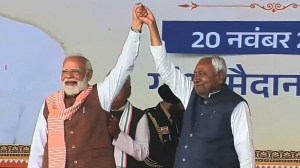Listless Indians curse that four-letter word: luck
The kind of ball he might have cheerily flicked over the midwicket boundary on another day,at another time.
A leg-stump full toss. The kind of ball he might have cheerily flicked over the midwicket boundary on another day,at another time. Now,though,all Virender Sehwag could do was pop it back to the bowler off the leading edge. Peter Siddle,who is developing a useful ability to pick up wickets as soon as coming on with fairly ordinary deliveries sometimes stretched across to his right and plucked the ball out of the air.
In the next over,Ben Hilfenhaus got one to deviate a hint off the pitch and into Rahul Dravid,from well back of a length. On another day,at another time,Dravid might have gone on tiptoe and dropped the ball at his feet,with that familiar smothering motion of his bat. Here,the ball ricocheted off his right elbow at a steep downward angle and knocked out his bails. Bowled,yet again.
For the first time in the series,India were batting in entirely batsman-friendly conditions. Sehwag had been looking like the old Sehwag,flicking Hilfenhaus to the midwicket fence,punching Ryan Harris for successive fours through point. Hed even enjoyed a stroke of luck,Ed Cowan diving to his left and grassing an airborne ball at midwicket. But the luck wasnt to hold out. Both dismissals contained a sizeable element of fortune. It was enough to make you believe,perhaps,that the Indian teams time wasnt good.
Sehwag himself had said this on the eve of the Test,when asked to put his finger on the unending batting collapses. In 2008-09,everyone scored runs, he said. From top order to middle order,everyones time is not good now. As a team at least 2-3 batsmen have to do well and score centuries. Im a great believer that the time is not good.
Since then,the fatalism has spread quickly to the rest of his team. At the end of Day One,Ravichandran Ashwin spoke once again of bad luck. I have repeated this many number of times that the rub of the green hasnt gone our way, he said. I feel awkward saying that again and again,but you cant really help.
Ashwin had been asked about Ishant Sharmas tendency to beat the bat and find edges that flew wide of fieldsmen or into gaps. At the end of Day Two,Ishant himself was available to talk about Indias performance. We have been unlucky, he said. Bowling the right areas,going past the bat,even if they are getting the edge,its not going near the fielder. You cant control all those things.
Never mind that the bowlers didnt really hit those right areas with any sort of consistency.
Little introspection
Bad luck alone cannot cause a team to lose seven overseas Tests in a row. But the Indian team seems to think it can. At no stage of the tour have any of the players sounded introspective about their failures. They might be,in the dressing room and in the nets,but it hasnt been apparent in their statements to the press.
Moreover,the administrators havent sounded too keen to look within themselves,or the structures Indian cricket is built on,to find out what has gone wrong. After the England tour,BCCI president N Srinivasan had ruled out any inquiry into their performances.
Yes,we did not do as well as expected, he said. But it happens. We have belief in this team and we believe that this team will bounce back very well.
Just before the Adelaide Test,Srinivasan said pretty much the same thing about the Australian debacle. A little bit of luck and I think the results would have been different.
Luck. That word again. After being whitewashed in the 2006-07 Ashes,the England board set up an independent inquiry into what went wrong. Plenty of changes came out of it,including the setting up of the England Lions. At this juncture,when a batting transition seems overdue,India could do with a development squad run on those lines,with talent identified in advance and given technical support and overseas experience before the call-up to the national side.
Last year,Australia set up an inquiry after losing their second straight Ashes series. What came out of it was a massive upheaval in the selection structure,with an increase in the powers vested in the captain and coach. Its hard to say if their improved displays are a result of the inquiry,but the need for urgent change wasnt ignored. The BCCI didnt react quickly enough after England. They might want to now.



- 01
- 02
- 03
- 04
- 05




























